Abstract
We consider a time series with real data from a water lift station, equipped with three water pumps which are activated and deactivated depending on certain starting and halting thresholds. Given the water level and the number of active pumps, both read every 5 min, we aim to infer when each pump was activated or deactivated. To do so, we build an algorithm that sets a hierarchy of criteria based on the past and future of a given interval to identify which thresholds have been crossed during that interval. We then fill the gaps between the 5 min time steps, modeling the water level continuously with a piecewise linear function. This filling takes into account not only every water level reading and every previously identified change of status, but also the fact that activation and deactivation of a pump has no immediate effect on water level. This allows for the fulfillment of the ultimate objective of the problem in its real context, which is to provide the water management company an estimate of how long each pump has been working. Additionally, our estimates correct the errors contained in the time series regarding the number of active pumps.
Keywords:
gap filling; time series; error correction; discrete-to-continuous model; water pump system MSC:
93A30; 65G20
1. Introduction
A certain water lift station, receiving a continuous but variable and unknown flow of water, is equipped with three water pumps to release water and thus prevent the overflow of the tank. Activation and deactivation of the pumps depends on the water level (measured in meters), according to predefined thresholds, as given in Table 1 and explained next. The tank is also equipped with sensors that read, at 5 min intervals, the water level and the number of active pumps. In order to better understand the scope of our objectives, a small sample of the database, which spans an entire year, is displayed in Table 2.

Table 1.
Activation and deactivation thresholds.

Table 2.
Sequence of 20 rows of the original data set.
We shall denote the thresholds , and using , and , respectively, and the thresholds , and using , and , respectively. We will refer to , and as the upward thresholds and to , and as the downward thresholds. We denote, using , the number of active pumps at time step n and refer to it as the status of the system at time n.
The system operates according to the following rules. In case no pump is active and an increasing water level reaches , the first pump is activated. Similarly, in case only one pump is (or, respectively, two pumps are) active and the water level reaches (or, respectively, ), a second (or, respectively, third) pump is activated. Analogously, in case all three pumps are working and the water level drops below , one pump is deactivated; if the level keeps lowering and reaches , another pump stops working, and if the level reaches the level , the remaining active pump is switched off. In other words:
- When none of the pumps is working, the status of the system will not change unless the water level reaches ;
- When only one pump is working, the status of the system will not change unless the water level reaches or drops below ;
- When two pumps are working, the status of the system will not change unless the water level reaches or drops below ;
- When all three pumps are working, the status of the system will not change unless the water level drops below .
Figure 1 shows, for 60 consecutive entries of the database (the first 20 of which constitute the data given in Table 2), the water level and the corresponding number of active pumps as given in the data set.
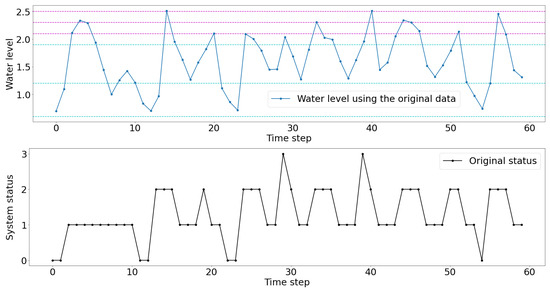
Figure 1.
The water level and the number of active pumps for 60 consecutive entries of the database.
Whereas the data relative to the water level can be considered accurate (apart from occasional typos, such as negative values and values significantly below or above ), the data relative to the number of active pumps is easily seen to contain errors. For example, in Reading 3 from Table 2, the correct number of active pumps must be at least 2, since the water level had already reached , prompting a second pump to switch on (for a better visualization, we refer to Reading 4 on Figure 1, where the threshold is clearly attained). Another example is Reading 14, where the level was already reached, so the number of active pumps is 3, and it should only decrease to 2 at Reading 16, when is reached. Whenever detected, these values are replaced with one consistent with the remaining data, and we will make a thorough description in Section 2 of the criteria to determine the correct value at each time step.
In order to estimate for how long the pumps have been working, we model the level of the water continuously, so that we may estimate at which instant a pump has been activated or deactivated. To do so, we first identify under which conditions one or more thresholds have been attained in the interval of time under analysis, according to the data for the near past and near future of the interval. We then design an algorithm that models the water level, taking into account the switching on and off of the pumps, as well as an associated delay.
Given that both the data and common sense suggest that the effect of a pump being activated or deactivated may not be immediate and that the influx of water is variable and unknown, we consider a minimum delay of 5 s and a maximum delay of 15 s. Although empirical, these values are sustained by the data. For example, there exist readings above an upward threshold which are followed by a decrease in water level, meaning that the water level did not start to decrease immediately after the threshold was attained. Further evidence of this fact is the existence of values below and above . Thus, let and (measured in time steps). Delays within and are called admissible.
Concerning the literature on this framework, several recent works used machine learning tools to address problems, and goals, similar to ours. For example, in [1], the authors take an approach to fill gaps on a scarce data time series using the MissForest algorithm, and, in [2], gap filling is achieved by means of automated evolutionary identification of the optimal structure for a composite data-driven model. Our data set, however, contains a large number of errors in the status time series and thus does not provide a reliable training set for the application of machine learning regression techniques to infer the status of the system. Therefore, even though the status inference (with errors) from the water-level time series has an accuracy of by means of the application of a random forest algorithm (cf. the public GitHub repository indicated at the end of this work), this will not allow for acquisition of the real status values, since it accurately predicts the status with those errors.
In [3], a multiple-point statistics algorithm suited for pattern reproduction is used. The main advantage of this method is its ability to provide probabilistic estimates of the missing values, which allows for uncertainty quantification. Although uncertainty is obviously also present in our problem, in our framework, pattern recognition benefits greatly from taking into account contextualized hands-on information about the system. For this reason, we favored an approach of a more deterministic nature, where uncertainty is addressed by providing criteria that establish which status change is most likely to have happened. The subsequent data gaps are then filled by means of several synchronized steps of linear interpolation.
A different, but related, possible approach to status inference would be an error-correction method, similar to those studied in [4] in an econometrics environment. Our framework is not related, since the corrections that we are interested in are based on empirical information and not on any difficulty in finding a fit model that performs the regression between the two time series.
Regarding data completion, we note that, in our problem, the gaps are the time values between the 5 min time steps instead of the erratic and larger gaps often considered in the literature. Several regression methods for gap filling between regular time steps can be found easily in the literature. For example, in [5], the author gives some insight on how to fit a discrete data time series into a continuous time function. Again, in our framework, the complexity arises from information outside the data set (threshold crossing and delays) and not with any difficulty in finding an appropriate regression model in particular. Other methods range from simple linear models to complex deterministic or stochastic techniques. Common approaches include, for example, the simple nearest neighbor method via data transfer [6], interpolation techniques [7], auto-regressive models [8], and simple and multiple regressions [9].
In short, to accomplish our goal, we first design an algorithm to predict the system status. Based on the previous and next water level readings of a given time step, this procedure identifies the thresholds, if any, that have been crossed between this and the following time step. Next, we define rules to model the water level, filling the gaps between the 5 min time steps continuously with piecewise linear functions. These rules follow these required principles:
- Take the water level readings from the original data set as constraints, since these are considered to be correct;
- Have the water level behave according to every previously identified change of status;
- Take into consideration the fact that the effect of the activation and deactivation of a pump on water level is not immediate, but rather comes with a certain delay.
Combining the status inference—that is, the estimated number of active pumps at each reading—with the estimated water level, we are able to determine the moment when each pump has been activated or deactivated. This allows for fulfillment of the company’s ultimate objective, which is to estimate for how long each pump has been active.
This paper is organized in the following way: in the next section, we determine the conditions under which the status of the system changes; in the following section, we define how the gaps between readings should be filled for each type of transition; the fourth section is devoted to the implementation of Section 2 and Section 3 on a sample of the data set; and in the final section, we present an analysis of the results obtained.
2. Inferring the System Status
As stated before, we consider the water-level time series to be accurate, and so any incoherence between the water-level readings and the number of active pumps is due to an error in the latter.
In this section we will describe a detailed procedure to obtain the correct status of the system at every time step n, and to do this we must consider what happens both before and after n. Moreover, the conclusions will be obtained using not only the water-level readings, but also the rate changes, in order to encompass the trend of the water level. The procedure not only addresses the reasons to infer changes in the status, but it also establishes prioritization criteria that allows us to settle which changes are the most likely to have occurred.
Let denote the rate corresponding to the difference between the water level at time step n and . If the line that contains and and the line that contains and intersect within , we denote the x-coordinate of this point using . Figure 2 exemplifies the existence and non-existence of .
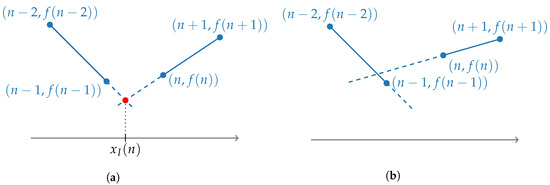
Figure 2.
Example of existent and non-existent . (a) The x-coordinate of the intersection belongs to . (b) The x-coordinate of the intersection does not belong to .
An analysis of the data set allows us to infer some useful properties of the system, namely:
- for the whole data set;
- for the whole data set;
- If , then (this means that whenever all the pumps are simultaneously active, the water level decreases);
- If , then (this means that the minimum inflow of water into the system is of m per 5 min). As a consequence, since , the system is never fully turned off for more than three time steps;
- If and , then some threshold must have been crossed within —if not within nor , then within ;
- If , and , then the upward threshold was crossed;
- Similarly, if , and , then the downward threshold was crossed;
- If or , then the corresponding threshold was crossed.
Next, we establish the conditions under which the system status changes from a time step to a time step n. For simplicity and ease of reference, these conditions are listed in Table 3, Table 4, Table 5 and Table 6.

Table 3.
Conditions for status change with .

Table 4.
Conditions for status change with .

Table 5.
Conditions for status change with .

Table 6.
Conditions for status change with .
The main challenge is, of course, to identify which conditions imply that a certain status change takes place. Based on the analysis above, we consider four distinct conditions as evidence of a change from a status k to a neighbouring status and three distinct conditions as evidence of a change from a status k to a non-neighbouring status with . Moreover, due to the fact that the transition from a status k to a status and the transition from a status to a status , both being transitions between neighbouring statuses, share similarities between them, the four conditions are precisely of the same type in both cases. The same applies to transitions between non-neighbouring statuses. Thus, overall, will be different than if one of the following occurs:
- (a)
- An explicit crossing of the relevant threshold;
- (b)
- Evidence of the trend before and the trend after n meeting at a water level higher/lower than or close enough to the relevant threshold within more likely than later on;
- (c)
- For changes between neighbouring statuses, evidence of a sharp change from a positive/negative to a negative/positive ;
- (d)
- Evidence of a significant change from a positive/negative to a negative/positive coexisting in a reading close to the relevant threshold.
We shall detail the transition of to , with the remaining transitions following analogous reasoning. As shorthand to make our arguments more concise, in the remainder of this work, both the conditions and will always be considered satisfied if exists and does not exist.
For to go from 2 to 3 between and n, the water level must have reached the upward threshold during this interval. This is obviously the case if the water level is at least at n, that is, if . Since this is a condition of type “a”, we shall denote it with (23a). Of course, it may also happen that, although was attained during the interval , the water level is no longer above by the time reading n takes place. One evidence of this fact is that the trend before and the trend after n meet at a water level higher than or close enough to within , that is, , along with an extra condition, , which ensures that the change is more likely to have happened in than later on. Since this condition is of type “b”, we labeled it (23b). Given that 2 and 3 are neighbouring statuses, a sharp change from a positive to a negative is also indicative of the water level having attained during . Thus, having and , along with the same extra condition, , which was included in (23b), is evidence of a status change from 2 to 3, and will be labeled (23c). Figure 3 illustrates conditions (23b) and (23c), according to whether sits below or above , respectively. Finally, if a significant change from a positive to a negative coexists in a reading close to , quantified as , , we also consider that the status changed from 2 to 3. This condition is labeled (23d). If none of the conditions (23a), (23b), (23c) or (23d) is met, we conclude that the status remains unchanged.
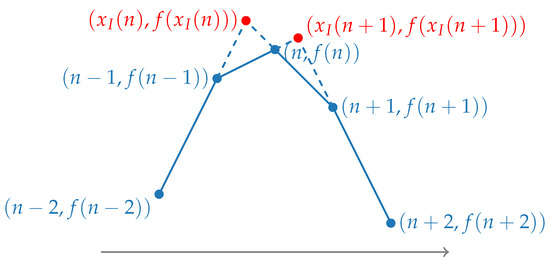
Figure 3.
Illustration of conditions (23b) and (23c).
It is also important to note that the order in which these conditions should be verified, given a status , is not entirely random. To prevent the change from being underestimated, the status farthest possible from k must be checked first, the status second farthest from k must be checked next, and so on (but it makes no difference whether one first checks if or ).
3. Data Gap Completion
Having established that the status of the system will change from a time step to a time step n—along with exactly which change will take place and the reason such a change will occur, that is, the type of condition (“a”, “b”, “c” or “d”) that applies—we aim to continuously describe the water level, completing the information that the system does not convey regarding the water level. In this section, we establish how this completion should be accomplished for each of the status transition conditions identified in the previous section. We detail the procedure to follow for crossing the upward thresholds, since crossing the downward thresholds has entirely symmetrical consequences on the water level. Recall that we always allow for a delay, between and , from the instant when a pump is activated or deactivated to the instant when its effect on the water level takes place.
To ease the notation, the water level at time step n will be denoted as instead of , and the rate will be denoted as . If the line segment that joins and intersects or, in case this intersection does not exist, if the line segment that joins and intersects , we denote this point as .
In case there is no change of status between readings and n, the water level is given by the linear function that joins and . The task is thus to establish how to fill the gaps when it has been determined that the status changed between two consecutive readings. The procedure must ensure that the relevant threshold(s) was(were) indeed crossed, verify the existence of a delay within the given limits, and verify a change in the rate of the water level once this delay is fulfilled. This is accomplished with a piecewise linear function, with the smallest possible difference from the linear function connecting the readings.
The procedure also takes into account the type of condition that sustains the status change. In fact, if the condition is of type “a”, we have a reading above/below the relevant threshold, so that it is guaranteed that the water level will cross the threshold (and the adjustments to make, if any, have to do with ensuring an admissible delay), whereas in a condition of type “b”, this crossing must be accomplished between and n. Likewise, conditions of type “c” and “d” have their own specificity. On the other hand, the procedure functions differently accordingly to the number of thresholds crossed. Therefore, we consider the following cases (recall that conditions of type “c” only exist for transitions between neighbouring statuses):
| A1/A2/A3: | for transitions of type “a” in which 1/2/3 thresholds are crossed; |
| B1/B2/B3: | for transitions of type “b” in which 1/2/3 thresholds are crossed; |
| C1: | for transitions of type “c”; |
| D1/D2/D3: | for transitions of type “d” in which 1/2/3 thresholds are crossed. |
The remainder of this section is devoted to describing the procedure followed in each of these cases.
3.1. Case A1: Transitions of Type (01a), (12a) and (23a)
In this case, is given by the intersection of a line segment that joins and with . Notice that represents the delay by which the water level is affected following the crossing of (and consequent activation of the pump). There are three sub-cases to consider:
A1 (i). A1 (ii). A1 (iii). .
Case A1 (i) requires no intervention, since the delay is within the admissible values. If A1 (ii) occurs, we shift the maximum towards the right, along the line segment that joins and , in order to comply with the minimum delay, that is, a delay of . Notice that the water level at the new maximum will not exceed . In fact, since the maximum is attained at , for the water level to reach the next threshold, we would have
which is impossible in this framework. Finally, in case A1 (iii), we split the the line segment that joins and into two line segments. If and , the break point will be at along the line that contains and —since sits to the left of , we thus ensure a delay of ; since , the water level at will be at most , and so is not reached. If or , the first line segment leaves with a slope of and halts at —again, the delay of is ensured, and, since in this framework, is guaranteed as well. In either case, the second line segment is the one that joins the break point and .
Figure 4 illustrates sub-cases A1 (ii) and A1 (iii). The blue dots represent actual data entries (and blue line segments represent the water level as given directly by the readings), and the red dots represent additional break points, as given by the rules adopted (and red line segments represent the corrected water level). The purple (respectively, light blue) dashed lines help to locate the upward (respectively, downward) thresholds. This color code will be adopted throughout the entire work.
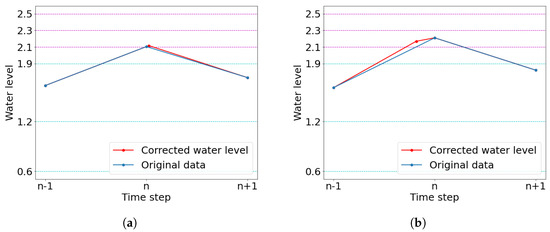
Figure 4.
Two sub-cases of case A1. (a) Illustration of sub-case A1 (ii): , and . (b) Illustration of sub-case A1 (iii): , and .
3.2. Case B1: Transitions of Type (01b), (12b) and (23b)
This turn, is given by the intersection of a line segment that joins and with . We consider the following sub-cases:
- B1 (i):
- B1 (ii):
- B1 (iii):
- B1 (iv): .
Again, case B1 (i) requires no correction. In case B1 (ii), we proceed as in case A1 (ii), using instead of . In case B1 (iii), we lower to , so that the line segment that joins and intersects in such a way that the delay equals . To be precise, we have
Finally, in case B1 (iv), we proceed symmetrically to case B1 (iii), shifting the point upwards to , but this turn occurs in order to get a delay of , namely,
Figure 5 illustrates sub-cases of (iii) and (iv) of case B1. The dotted line segments indicate the extension of the previous or future line segments, and so is their intersection point.
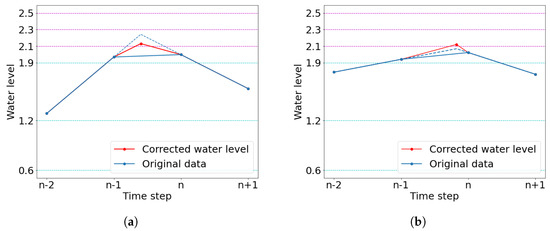
Figure 5.
Two sub-cases of case B1. (a) Illustration of sub-case B1 (iii): and (with and ). (b) Illustration of sub-case B1 (iv): and (with and ).
3.3. Case C1: Transitions of Type (01c), (12c) and (23c)
In the case when exists, but case B1 does not apply (and so ) and the evidence of a threshold crossing comes from the sharp change from to (in this case, from a positive to a negative ) along with (or the non-existence of ), we nonetheless proceed as in case B1 (iv).
3.4. Case D1: Transitions of Type (01d), (12d) and (23d)
This turn, the evidence of a threshold crossing is given by a reading close to a threshold together with a significant change and opposite signs in to . We proceed similarly in the two sub-cases
considering we extend the line segment with the greatest incline, allowing for a minimum delay. Figure 6 illustrates the sub-cases of (i) and (ii) of case D1, respectively.
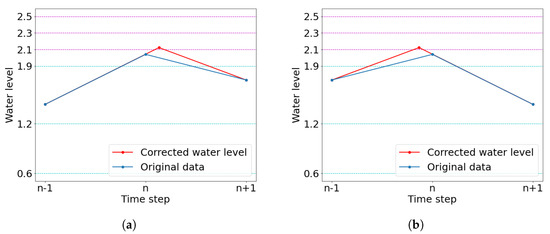
Figure 6.
The 2 sub-cases of case D1. (a) Illustration of case D1 (i): , and ). (b) Illustration of case D1 (ii): , and .
3.5. Case A2: Transitions of Type (02a) and (13a)
In this case, one or two additional break points are defined, following the same principles that were adopted in case A1. Given that the uncorrected version yields an exaggerated delay after the first threshold has been reached, we first proceed as in case A1 (iii). Therefore, we split the line segment between and into two line segments, with a break point sitting to the left of the point where the line segment that joins and meets the first threshold. Next, we consider the line segment that joins the first break point and and again apply the appropriate the sub-case of A1. Figure 7 illustrates an instance of case A2.
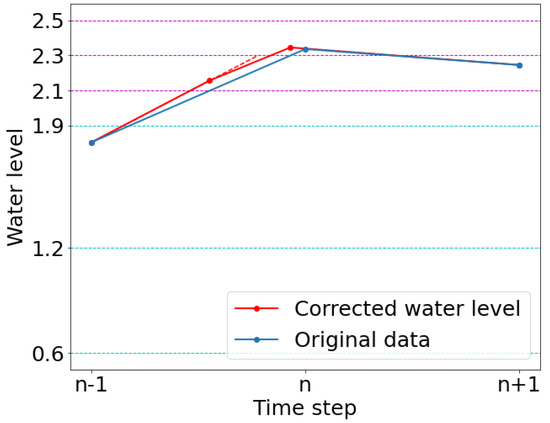
Figure 7.
Illustration of case A2: , and . The dotted extension of the first line segment shows how the slope of the water level decreases after the first break point. In this example, the line segment joining the first break point and yields an excessive delay, and so the second break point is again found as in A1 (iii).
3.6. Case B2: Transitions of Type (02b) and (13b)
As in case B1, is given by the intersection of a line segment that joins and with . We set a first break point at along the line that contains and . In case the line segment that joins the first break point and yields an admissible delay when crossing the second threshold, we take to be the local maximum; otherwise, we proceed as in cases B1 (ii), (iii) or (iv), adjusting the maximum value in order of the corresponding delay to be within the interval . Figure 8 illustrates case B2.
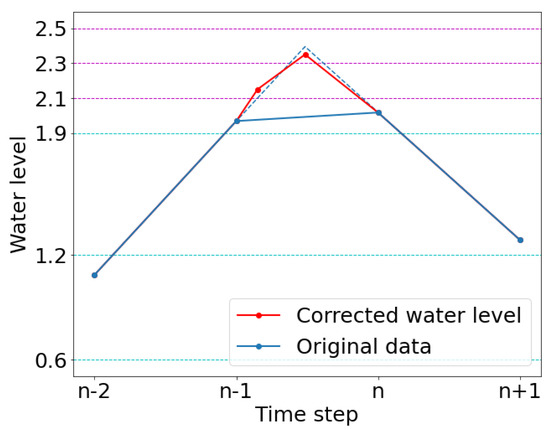
Figure 8.
Illustration of case B2: and ( with and ).
3.7. Case D2: Transitions of Type (02d) and (13d)
Here, we determine a first break point using the procedure established for case A1 (iii) and then apply the appropriate sub-case of case D1, according to whose line segment has the greatest incline: the line segment joining the first break point and or the line segment joining and .
3.8. Case A3: Transitions of Type (03a)
This case is dealt with analogously to case A2, now with the introduction of an extra initial break point. In order to obtain a more natural decay in the rate of the water level, we consider that the water level reaches at (thus anticipating the crossing of the first threshold) and that the first break point occurs at .
3.9. Case B3: Transitions of Type (03b)
Analogous to case A3, we introduce the extra initial break point, as defined there, and then proceed as in case B2.
3.10. Case D3: Transitions of Type (03d)
Again, we introduce the extra initial break point and then proceed as in case D2.
4. Implementation on a Sample of the Data Set
In this section, we apply the algorithms from Section 2 and Section 3 to a sample of the data set and analyse the results obtained. For purposes of this exercise, and since the initial reading is , we consider that the status for the first reading, as given in the data set, is correct. Thus, .
We begin by inferring the status of the system as described in Table 3, Table 4, Table 5 and Table 6. The status change condition, if any, that applies to each row of the sample displayed in Table 2, together with the corrected status of the system, is indicated in Table 7. Figure 9 shows the water level as given by the data along with the points , when they exist. As we saw in Section 2, these points are instrumental when deciding the status transitions.

Table 7.
Sequence of 20 rows of the data set with the system status correction.
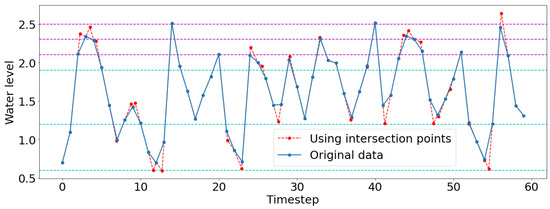
Figure 9.
The water level using the readings and the existing intersection points for a sample of the data set.
Figure 10 exhibits the comparison between the system status given in the data set and the corrected status at each time step (in black, as given by the data set, and in red, as given by the status inference set up in Section 2). Overall, this sample of the original data set yields a total of 78 5-min “active intervals”, that is, 5-min intervals (some of which coincide in time) during which a pump was active, whereas the corrected version yields a total of 89 such intervals.
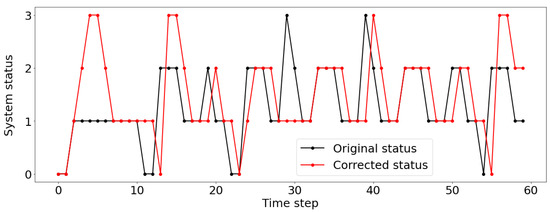
Figure 10.
The system status for a sample of the data set, as given in the data set and by its correction using the rules established in Section 2.
For comparison, we remark that, in the original (complete) data set, there were 7971 5-min intervals in which no pump was working, 53,107 5-min intervals in which one pump was working, 8924 5-min intervals in which two pumps were working and 41 5-min intervals in which all pumps were working. Applying the status inference algorithm to the whole data set, these figures become 9251, 39,531, 18,120 and 3141, respectively. It is particularly striking how the full operation of the pumps was being underestimated.
Detailing individually for each of the three pumps, the correction of the status determined by Section 2 yields a total of 30 5-min active intervals for pump 1, 21 5-min active intervals for pump 2 and 38 5-min active intervals for pump 3. (This analysis, impossible to perform on the original data on account of its incoherence, uses the modus operandi of the system: when activating a pump, the system chooses the one that has been switched off longest and similarly for deactivation.)
Taking into account the modeling of the water level set up in Section 3, which always anticipates or delays the change of status, these values become , and , respectively. Thus, comparing the un-modeled with the modeled version, pump 1 works approximately less of the time, pump 2 works approximately less of the time, pump 3 works roughly the same time, and the system works approximately less of the time (the total having become 5-min units). Figure 11 displays the comparison between the moment when each pump is activated and deactivated (in black, as given by the status inference algorithm from Section 2, and in red, as given by the modeling established in Section 3).

Finally, Figure 12 displays the water level as given by the original data (blue dashed line) and the water level as modeled in Section 3 (red continuous line). For a better visualization, we focus on the first 20 entries of the sample under analysis. These graphs show how the gap completion preserves the water level readings and the extra break points introduced by this algorithm, with the consequent anticipation/retardation of the crossing of the thresholds when compared with the original data. The crossing of every appropriate threshold(s) and the delayed effect of the activation and deactivation of the pumps after each threshold crossing on the water level can also be observed. The outcome is that the response of the system is always coherent with its operating mode.
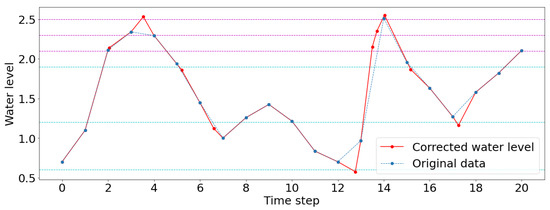
Figure 12.
The water level for the first 20 entries of the sample, as given in the data set and by its correction using the modeling established in Section 3.
5. Conclusions
The algorithm defined in Section 2 allows for the extraction of the correct values of the status time series at every 5-min step, correcting the existing errors on the original data set. Although one of the objectives of this work, these figures alone do not provide the water management company the information needed on the number of active pumps on a continuous level. For example, if a pump was activated at 12:04:30 and deactivated one minute later, the status would be 1 for a time step, falsely implying that the pump worked for 5 min; if the same situation occurred at 12:03:00, the status would not reach the value 1 on the adjacent time steps, and it would be inferred that the pump had always been off. Both situations represent significant errors. With the algorithm described in Section 3, we were able to tackle this problem, providing a means to extract the desired information: the moment when each pump was activated or deactivated. As shown in Section 4, even for a small sample of the data set, the corrections, both on the status time series and on the amount, are not negligible.
As for future perspectives, this work could provide more accurate results if the data for the incoming water in the tank is taken into consideration. As of today, the water management company only has daily data for this variable, which of course is not useful for the intended estimate. Another aspect that could be looked upon is the specificity of each pump. By evaluating the water lifting capacity of each pump, we could build a model that not only provides lifting profiles closer to reality, but also incorporates in the model possible differences between the pumps.
Author Contributions
Conceptualization, R.E. and F.S.; Methodology, R.E. and F.S.; Software, R.E. and F.S.; Validation, R.E. and F.S.; Formal analysis, R.E. and F.S.; Resources, R.E.; Writing—original draft, R.E. and F.S.; Writing—review & editing, R.E. and F.S. All authors have read and agreed to the published version of the manuscript.
Funding
This research received no external funding.
Institutional Review Board Statement
Not applicable.
Informed Consent Statement
Not applicable.
Data Availability Statement
The data set used in this work, as well as the code with the algorithm developed in Python, are available at the public GitHub repository: https://github.com/RicardoRoqueEng/DataSetGapCompletion.git (accessed on 15 February 2023).
Acknowledgments
The authors gratefully acknowledge the support given by FCT projects UIDB/04621/2020 and UIDP/04621/2020 of CEMAT at FC-Universidade de Lisboa.
Conflicts of Interest
The authors declare no conflict of interest.
References
- Arriagada, P.; Karelovic, B.; Link, O. Automatic gap-filling of daily streamflow time series in data-scarce regions using a machine learning algorithm. J. Hydrol. 2021, 598, 126454. [Google Scholar] [CrossRef]
- Sarafanov, M.; Nikitin, N.O.; Kalyuzhnaya, A.V. Automated Data-Driven Approach for Gap Filling in the Time Series Using Evolutionary Learning. In Proceedings of the 16th International Conference on Soft Computing Models in Industrial and Environmental Applications (SOCO 2021); Sanjurjo González, H., Pastor López, I., García Bringas, P., Quintián, H., Corchado, E., Eds.; Springer International Publishing: Cham, Switzerland, 2022; pp. 633–642. [Google Scholar] [CrossRef]
- Dembélé, M.; Oriani, F.; Tumbulto, J.; Mariéthoz, G.; Schaefli, B. Gap-filling of daily streamflow time series using Direct Sampling in various hydroclimatic settings. J. Hydrol. 2019, 569, 573–586. [Google Scholar] [CrossRef]
- Granger, C.; Weiss, A. Time Series Analysis Of Error-correction Models. In Studies in Econometrics, Time Series, and Multivariate Statistics; Karlin, S., Amemiya, T., Goodman, L.A., Eds.; Academic Press: Cambridge, MA, USA, 1983; pp. 255–278. [Google Scholar] [CrossRef]
- Jones, R.H. Fitting A Continuous Time Autoregression To Discrete Data. In Applied Time Series Analysis II; Findley, D.F., Ed.; Academic Press: Cambridge, MA, USA, 1981; pp. 651–682. [Google Scholar] [CrossRef]
- Bárdossy, A.; Pegram, G. Infilling missing precipitation records – A comparison of a new copula-based method with other techniques. J. Hydrol. 2014, 519, 1162–1170. [Google Scholar] [CrossRef]
- Hughes, D.; Smakhtin, V. Daily flow time series patching or extension: A spatial interpolation approach based on flow duration curves. Hydrol. Sci. J. 1996, 41, 851–871. [Google Scholar] [CrossRef]
- Tencaliec, P.; Favre, A.C.; Prieur, C.; Mathevet, T. Reconstruction of missing daily streamflow data using dynamic regression models. Water Resour. Res. 2015, 51, 9447–9463. [Google Scholar] [CrossRef]
- Dumedah, G.; Coulibaly, P. Evaluation of statistical methods for infilling missing values in high-resolution soil moisture data. J. Hydrol. 2011, 400, 95–102. [Google Scholar] [CrossRef]
Disclaimer/Publisher’s Note: The statements, opinions and data contained in all publications are solely those of the individual author(s) and contributor(s) and not of MDPI and/or the editor(s). MDPI and/or the editor(s) disclaim responsibility for any injury to people or property resulting from any ideas, methods, instructions or products referred to in the content. |
© 2023 by the authors. Licensee MDPI, Basel, Switzerland. This article is an open access article distributed under the terms and conditions of the Creative Commons Attribution (CC BY) license (https://creativecommons.org/licenses/by/4.0/).